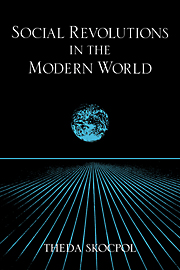Book contents
- Frontmatter
- Contents
- Acknowledgments
- INTRODUCTION
- I DOING MACROSCOPIC SOCIAL SCIENCE
- 1 A critical review of Barrington Moore's Social Origins of Dictatorship and Democracy
- 2 Wallerstein's world capitalist system: A theoretical and historical critique
- 3 The uses of comparative history in macrosocial inquiry
- II MAKING SENSE OF THE GREAT REVOLUTIONS
- III A DIALOGUE ABOUT CULTURE AND IDEOLOGY IN REVOLUTIONS
- IV FROM CLASSICAL TO CONTEMPORARY SOCIAL REVOLUTIONS
- CONCLUSION
- Index
3 - The uses of comparative history in macrosocial inquiry
Published online by Cambridge University Press: 05 June 2012
- Frontmatter
- Contents
- Acknowledgments
- INTRODUCTION
- I DOING MACROSCOPIC SOCIAL SCIENCE
- 1 A critical review of Barrington Moore's Social Origins of Dictatorship and Democracy
- 2 Wallerstein's world capitalist system: A theoretical and historical critique
- 3 The uses of comparative history in macrosocial inquiry
- II MAKING SENSE OF THE GREAT REVOLUTIONS
- III A DIALOGUE ABOUT CULTURE AND IDEOLOGY IN REVOLUTIONS
- IV FROM CLASSICAL TO CONTEMPORARY SOCIAL REVOLUTIONS
- CONCLUSION
- Index
Summary
Comparative history is not new. As long as people have investigated social life, there has been recurrent fascination with juxtaposing historical patterns from two or more times or places. Part of the appeal comes from the general usefulness of looking at historical trajectories in order to study social change. Indeed, practitioners of comparative history from Alexis de Tocqueville and Max Weber to Marc Bloch, Reinhard Bendix, and Barrington Moore, Jr., have typically been concerned with understanding societal dynamics and epochal transformations of cultures and social structures. Attention to historical sequences is indispensable to such understanding. Obviously, though, not all investigations of social change use explicit juxtapositions of distinct histories. We may wonder, therefore: What motivates the use of comparisons as opposed to focussing on single historical trajectories? What purposes are pursued – and how – through the specific modalities of comparative history?
Certain areas of scholarly endeavor in contemporary social science have given rise to methodological reflection even more sophisticated than the substantive applications of the methods in question, but this has certainly not been the case for comparative history. Despite the steady application of variants of this approach to macrosocial topics such as revolutions, religious evolution, political development, economic “modernization,” patterns of collective violence, and the rise and fall of empires, there have been remarkably few efforts to explore the methodological aspects of comparative history as such in any systematic fashion.
- Type
- Chapter
- Information
- Social Revolutions in the Modern World , pp. 72 - 96Publisher: Cambridge University PressPrint publication year: 1994
- 2
- Cited by



